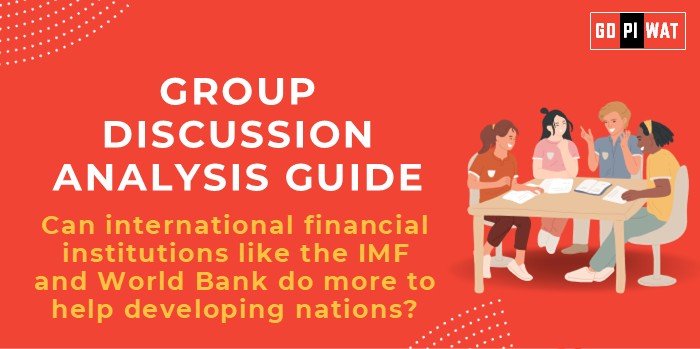📋 Group Discussion (GD) Analysis Guide
🌍 Can International Financial Institutions Like the IMF and World Bank Do More to Help Developing Nations?
💡 Introduction to the Topic
🌱 Context: International financial institutions (IFIs) like the IMF and World Bank have been pivotal in global economic stability, particularly in developing economies. These institutions influence policy reforms and infrastructure financing but face criticism for being inadequate or biased in their approaches.
📜 Background: Established post-World War II, these institutions aimed to foster global financial stability and reduce poverty. However, their role and efficacy in addressing the challenges of modern developing economies, such as climate change, debt crises, and technology gaps, remain contentious.
📊 Quick Facts and Key Statistics
- 💵 IMF Emergency Lending: $143 billion disbursed in response to the COVID-19 pandemic.
- 🌍 World Bank Climate Financing: $31.7 billion allocated in FY2022, the largest to date.
- ⚠️ Debt Crisis: 60% of low-income countries are in or at risk of debt distress (IMF, 2023).
- 📉 Poverty Impact: World Bank estimates 719 million people live on less than $2.15/day as of 2023.
🌍 Stakeholders and Their Roles
- 🏛️ IMF and World Bank: Lend financial support, enforce policy reforms, and promote economic growth.
- 🌐 Developing Nations: Seek affordable financing for development projects and debt relief.
- 💰 Donor Countries: Contribute funds but influence decision-making, sometimes to their advantage.
- 👥 Civil Societies and NGOs: Advocate for equitable and sustainable lending practices.
🏆 Achievements and Challenges
🌟 Achievements:
- ✔️ Debt Restructuring: Successful restructuring for countries like Zambia and Sri Lanka.
- 📈 International Development Association (IDA): Supports the poorest nations with initiatives targeting poverty reduction.
- 🌱 Climate and Infrastructure Programs: Programs targeting climate resilience and infrastructure development.
⚠️ Challenges:
- ⚖️ High Conditionalities: Loans often tied to austerity measures, impacting social programs.
- 🌍 Perceived Bias: Criticism for favoring Western donor nations in decision-making.
- 📉 Limited Focus: Insufficient attention to emerging global issues like digital equity.
🌍 Global Comparisons:
- ✅ Success: China’s use of the Asian Infrastructure Investment Bank (AIIB) as a parallel institution.
- ❌ Challenges: African nations’ struggle to reduce dependency on conditional IFI aid.
📜 Case Study:
- 🇬🇭 Ghana: Reliance on IMF bailouts, totaling 17 since 1966, showcases recurring debt cycles.
✨ Structured Arguments for Discussion
- 💬 Supporting Stance: “The IMF and World Bank have provided crucial financial stability and development financing that many developing nations could not secure independently.”
- ⚖️ Opposing Stance: “These institutions perpetuate dependency and impose restrictive policies that hinder genuine economic sovereignty.”
- 🔄 Balanced Perspective: “While their role is indispensable, significant reforms are needed to make their assistance equitable and impactful.”
🎯 Effective Discussion Approaches
📖 Opening Approaches:
- 📊 “Global challenges like the COVID-19 pandemic and climate change have spotlighted the evolving role of IFIs in supporting vulnerable nations.”
- 📜 “The IMF’s $143 billion COVID-response funding saved many economies but also renewed debates on debt sustainability.”
🔄 Counter-Argument Handling:
- ✔️ “Highlight successful IMF and World Bank reforms in countries like Rwanda to counter negative perceptions.”
- 💡 “Discuss alternative solutions, like the AIIB’s focus on infrastructure without heavy conditionalities.”
📈 Strategic Analysis (SWOT)
- 💪 Strengths: Global reach, vast financial resources, proven expertise in financial stability.
- ⚠️ Weaknesses: Bureaucracy, perceived donor influence, focus on short-term measures.
- 💡 Opportunities: Focus on climate finance, digital inclusion, and equitable global trade practices.
- 🚨 Threats: Competition from alternative institutions like AIIB and BRICS Bank.
📚 Connecting with B-School Applications
- 🌟 Real-World Applications: Analyze debt management frameworks or develop models for equitable financial inclusion as part of B-school projects.
- 💬 Sample Interview Questions:
- “How can IFIs adapt to the rising influence of regional banks like AIIB?”
- “What role can IFIs play in addressing the global climate crisis?”
- 📖 Insights:
- Understand policy-making through macroeconomic modeling.
- Study the political economy of IFI lending practices.


